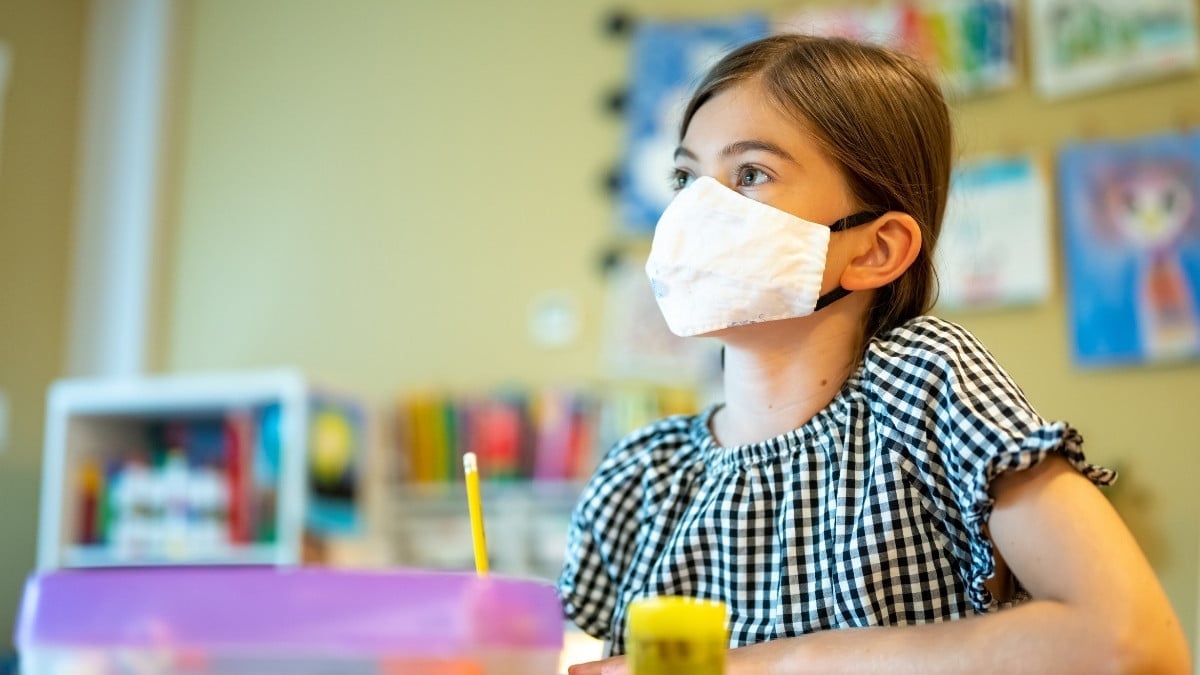As schools are now reopening, teachers must be wondering about how they can keep themselves and their students safe always. You can consider several COVID-19 precautions both inside and outside the classroom to prevent the transmission of the novel coronavirus.
Amid this pandemic, we have learned an important lesson about the role all teachers play to ensure that learning continues no matter what.
As schools reopen, many parents would rely on their children’s teachers to ensure that they’re sending their children to a safe and healthy environment; and compensate for the knowledge and skill that may have been lost due to the long in-school study break.
As a teacher, you should be well aware of the facts to keep yourself and your students safe. Be mindful of the myths and false information about COVID-19 that are circulating and feeding people’s worries and stigma.
Some children may have heard any false information regarding the novel coronavirus transmission. You need to educate them by conveying the facts and clearing their misconceptions.
The apprehension of COVID-19, how it transmits, and how we can safeguard ourselves and others is an essential first step in developing classroom measures and protocols.
Students need to perceive what it is in order for them to abide by the instructions. Pay attention to their challenges and ideas and respond to their questions in an age-appropriate manner.
Speak about the varied reactions they can experience and describe which reactions are normal and which are not.
Social Distancing At Schools
Social distancing is a vital precaution against COVID-19. The following tips will help you ensure social distancing at schools:
- Keep a distance of a minimum of 1 meter between whoever is present at school.
- Pay attention to desk spacing. There should be at least a 1-meter distance between the desks. Also, stagger lunch breaks and other breaks. If that seems to be difficult, you can instruct your students to have lunch at their own desks only.
- Restrict the combining of classes for school and after-school proceedings. For instance, students in a class will remain in one classroom throughout the day while teachers navigate between classrooms; or classes can use separate entrances if accessible, or pass an order for each class to enter and leave the classroom/building.
- Divide the school day to diversify the start and end times of classes. This will prohibit all teachers and students from coming together at once.
- Increasing the number of teachers can also be beneficial so that fewer students are there in each classroom.
- Shift lessons outdoors or ventilate rooms to the greatest extent possible.
- Employ signs, ground markings, barriers, tape, and other measures to keep a 1-meter distance in lineups around entrances.
- Motivate students not to assemble in large groups even after leaving the school premises.
Now, how to encourage your students to stick to the rules? Create and share a list of dos and don’ts with them.
Involve your students in this activity and discuss how they can greet each other; the way the desks will be arranged; social distancing measures during breaks; with whom they will sit or play; and how they can schedule the week to spend time with their friends safely.
Also Read: DELTACRON: A New Variant of Covid-19 or A Laboratory Accident?
Wearing Masks In School
If wearing fabric masks is advised in your school, then ensure your students are informed about when they should wear masks and any associated school policies, including how to discard used masks securely to eliminate the dangers of contaminated masks in classrooms as well as playgrounds.
Discover the best ways how to handle and store masks. All measures should be taken to make sure that the use of a mask is not interfering with learning.
No children should be exempted from access to education because of not wearing masks, considering the shortage of masks in the country.
If you have students with some disabilities in your class, such as auditory problems or hearing loss, then contemplate how those children may omit learning opportunities due to the debauched speech signal resulting from mask-wearing, physical distancing, the eradication of lipreading, and speaker expressions.
Tailored masks to enable lipreading (for example, clear masks) or face shields could be considered an option for fabric masks.
Health And Hand Hygiene as COVID-19 Precaution
Teachers have an essential role to play in making sure students fathom the preventive measures they must take to safeguard themselves and others from COVID-19, and you must serve as an example in the classroom precautions.
Handwashing is the simplest, most effective, and cost-effective way of tackling germs transmission and keeping students and staff safe and healthy.
Ensure Proper Handwashing With These Five Steps
- Wet the hands with clean, running water.
- Apply adequate soap to cover wet hands.
- Wipe all sides of the hands – including between fingers, backs of hands, and even under nails – for about 20 seconds. You can ask students to sing a brief song at this point to make it a pleasurable habit.
- Rinse completely with flowing water.
- Use a clean cloth or single-use towel to pat dry hands.
If there is a shortage of sinks, soap, or running water in the school, encourage your students to use a hand sanitiser containing at least 60% alcohol. Remember, warm water and cold water are equally effective in warding off germs and viruses as long as you are using soap with it.
Motivate students to get accustomed to the practice of frequent hand washing and/or applying hand sanitisers at critical moments, including entering and leaving the classroom, touching books, surfaces, learning materials, and utilizing a tissue to blow their nose.
Students should always sneeze/cough into their elbows. However, if by chance, they do so in/on their hands, recommend them to immediately wash their hands or apply hand sanitiser.
If students sneeze/cough into a tissue, make sure that it is discarded right away and that they wash their hands. It is really important to standardize the concept of routine and frequent handwashing.
Instruct your students not to touch their nose, mouth, and eyes even after disinfecting their hands.
Germs can move from those regions onto their clean hands and transmit around the classroom in this way.
If possible, place a good alcohol-based sanitiser in each classroom and near lunchrooms and toilets – and motivate children to use them frequently.
Below are certain practical steps that will help you ensure good hand hygiene practices for your students:
- Produce a hand hygiene song to sing with your students to ensure they’re washing hands for not less than 20 seconds at any time.
- Have students sketch hygiene posters for the classroom. Attractive posters will help stimulate them to maintain good hand hygiene.
- Establish a hand hygiene ritual. You can decide on a specific time during the day, for example, before or after lunchtime, for everyone to wash their hands or use hand sanitizers.
- Personally, show the procedure to wash hands and apply sanitizer appropriately.
- Introduce a points system in your classroom, providing points to students every time they wash their hands or use sanitizer.
Cleaning And Disinfecting for Precautions Against COVID-19
Gain insight on how to keep the cleanliness and sanitization of your classroom.
Ensure regular cleaning and disinfecting of objects and surfaces that are touched frequently, including doorknobs, desks, countertops, toys, taps, computer keyboards, hands-on learning items, and phones.
Clean objects and surfaces that are visibly soiled immediately.
In case any of the objects or surfaces are contaminated with blood or body fluids, use gloves, and other essential precautions to prevent coming into contact with the fluid. Wipe out the spill, and then clean and disinfect the surface.
Using Cleaning Materials: Tips For Staff
- Make sure you understand all instruction labels and know safe and correct use.
- Follow the guidelines mentioned on the labels.
- Cleaning products and disinfectants usually demand the use of gloves and/or eye protection. For instance, gloves should always be worn to shield your hands while working with bleach solutions.
- Don’t mix disinfectants and cleaners unless the labels suggest it is safe to do so. Combining some products (like chlorine bleach and ammonia cleaners) may cause serious injury or even death.
- Diluted household bleach solutions can also be used if suitable for the surface.
- Household bleach would be effective against coronaviruses when appropriately diluted.
- Do not mix household bleach with ammonia or with any other cleanser.
- Make sure to follow the manufacturer’s instructions for application and proper ventilation. Let the solution remain on the surface for at least 1 minute.
What To Do If One Of Your Students Seems To Be Sick?
Firstly check the symptoms of the students against COVID-19 symptoms in order to ensure precautions. The main symptoms of this infection include cough, fever, and tiredness.
Other common symptoms include headache, chest pain or pressure, shortness of breath, muscle or body aches, loss of smell or taste, sore throat, confusion, congestion or runny nose, skin rashes, abdominal pain, and diarrhoea, nausea, and vomiting.
Once you suspect that any child may be COVID-19 positive, call their parents and get them tested. Ask them to self-isolate themselves and their child until symptoms get recovered.
Sources:











